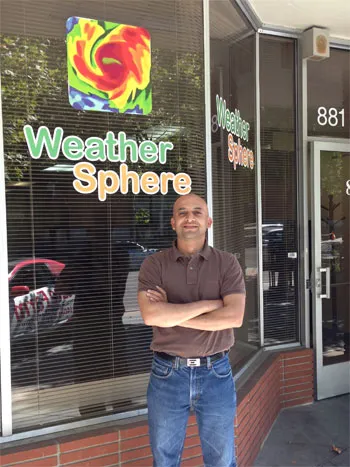Raghav Gupta, an entrepreneur who empowers people with accurate information during uncertain weather conditions

How often do you read an app review like the one captured above from iOS App Store for the app RadarCast Pro? This amazing app, along with a handful of other weather apps,is the brainchild of Raghav Gupta, Founder and CEO of WeatherSphere.
Whether it be tornadoes and thunderstorms in the mid-west, hurricanes in the south-east, snowstorms in the north, wild-fires in the west, or just planning their routine, millions of users across the US use the apps created by WeatherSphere every single day as part of their daily lives. WeatherSphere has earned this respect and trust from its users.
Raghav, a quick recap

Raghav didn’t have it all easy. He grew up with an average childhood in the city of Chandigarh, and came to the US to find his calling in life. He bought a one-way ticket to the US and landed at JFK airport in New York, 14 years ago, with no confirmed place to live and no job offer.He learned about harsh realities of life in his early days in the US. After a stint as an engineer in a startup where he was laid off en masse, he landed at eBay as an entry-level software engineer, where he worked his way up to eBay’s research lab unit. After filing 19 US patents and building great products at eBay, Raghav ultimately quit to start his own venture. He pivoted multiple times and finally launched WeatherSphere.Today, he is feeling the happiness of building a successful company from ground up and enabling millions of people to get access to some of the most accurate and real-time weather information available on mobile phones today.
Some of the apps that WeatherSphere has created are among the best-paid apps in the iOS App Store. One of the apps, Hi-Def Radar, has been the number 1 paid weather app for more than a year. Raghav has achieved all of this without raising any funding and has followed the lean startup model from the beginning.
YourStory catches up with Raghav to capture his amazing journey so far:
How was the idea of WeatherSphere born?
After quitting eBay, I had been tinkering with social networking apps. In 2011, I was in New York, travelling on a business trip. I woke up in the middle of night because my mobile phone was getting non-stop alerts about server health where the app was hosted. After logging in, I found that thousands of users were downloading an experimental app WeatherAlerts that I had released a month ago.The huge burst in app downloads was causing servers to crash because of increased load.
To get some time to fix the server issue, I quickly made the app paid, priced at $0.99. However downloads did not decrease, so I increased price to $1.99, then $2.99, but to no avail. I finally bumped the price to $4.99 and that leveled the app downloads sufficiently to keep things stable.Later, after doing some research, I found that people were using the WeatherAlerts app because there was a tornado warning in the mid-west. The app was designed to alert users to nearby tornadoes so they can seek safety.
After that incident, I started thinking about weather as a space for innovation. A few months later,another instance happened when a tornado hit a city in Missouri and it led to another burst of app downloads.
After both these events, I received several “thank you” messages from users and I was happy to hear that something I had built had helped in saving lives.At that point I decided to focus all my energies on developing better technology to help individual consumers get better access to real-time personalized weather information, and the idea for WeatherSphere was born.
What was the biggest challenge for you in building a company around WeatherSphere?
One of the major decisions I made in the early phase was to let go of available funding offers. Because I had early revenue, I was not dependent on external financing and we were able to grow organically.
The benefit of sticking to my decision was that I focused 100% of my energies on understanding what works and what doesn’t. I created a lean startup from the beginning. It was my money on the line, therefore every dollar spent had to be justified. Because of this focus, I focused on hiring people after I had complete confidence in them and that helped me in building a kick-ass team.
But I soon found out that being an un-funded company in Silicon Valley has its penalties, even if you are profitable and growing. If you are a small company with no big investors attached to it, you become an outlier with no backing, and it is very difficult to break that mold to be taken seriously.
Therefore, unless you already have a significant incoming revenue stream, I strongly advise entrepreneurs to not avoid the funding route simply because they can. If you want to grow at an explosive pace, then being part of the venture-backed ecosystem makes it a little easier.
Making a decision to not raise money when some prominent VCs are interested in investing in your business is a very big decision. Can you help our readers understand how you arrived at this decision?
The biggest reason was that I was already revenue positive with sufficient cash being generated to cover expenses for a small team. I realized that I could already do almost all the same things I would have done post-funding. From a simple business standpoint, it just didn't make sense to take on external financing if it was not needed.
You are competing against some big and established players in the industry such as Weather.com and AccuWeather. What do you think about them?
The weather industry is very concentrated and dominated by a few traditional players who are primarily focused on reporting weather via TV or web. However, people are moving toward a mobile-first world and that’s where WeatherSphere has an edge over conventional players in the weather industry.Our technology’s foundation is built upon today’s cloud infrastructure for scalability, and we have optimized delivery, ground up, for personalized mobile consumption, instead of designing for consumption by TV and radio stations. This makes all the difference in my view.
What’s next for WeatherSphere?
As it turns out, if you give your users a voice in the evolution of the product, they will partly show you the way. We have a whole bunch of innovations in the pipeline.Most (but not all) are derived from the thousands of user requests we get every year. Some of these are quite revolutionary as we will be revealing them soon. But, as a general practice, we will try to continue to lead this space and make ourselves more and more indispensable in people’s lives.
You have solved the problem of alerting users based on certain weather conditions in the US. Millions of people in India are dependent on agriculture. Do you think innovations like WeatherSphere can alert farmers in India to prepare and tackle the unpredictable weather patterns?
There is a huge gap in technology and infrastructure between the US and India. The US is probably one of the few countries in the world that has multiple weather radar installations blanketing its entire landmass. These radars capture weather information constantly and all of this data is publicly available in real-time. This FREE access to weather data makes it easier for startups like WeatherSphere to innovate and compete with established players like Weather.com.
India lacks such density of weather radar infrastructure and I am not sure if even the data collected currently is accessible to the public for free.If we have infrastructure similar to the US in India, it can definitely benefit not just farmers but many other organizations, groups and businesses that are affected by weather.
What have been the happiest moments for you while building this company?
We get numerous messages every day directly from users. Every once in a while a message is particularly heartfelt in describing how one of our apps helped save a life or was a big help in a bad situation. Some of them include deep personal details and are almost like mini-stories of how the app helped that person over an entire year. Needless to say, I am pretty grateful to be generating wealth and happiness while directly making a difference in people’s lives.
You can read more about Raghav on his blog post here
You can access various apps created by WeatherSphere here





![[Weekly funding roundup Dec 28-Jan 3] VC inflows kick off the year with a weak start](https://images.yourstory.com/cs/2/220356402d6d11e9aa979329348d4c3e/funding-lead-image-1669386008401.jpg?mode=crop&crop=faces&ar=1%3A1&format=auto&w=1920&q=75)

